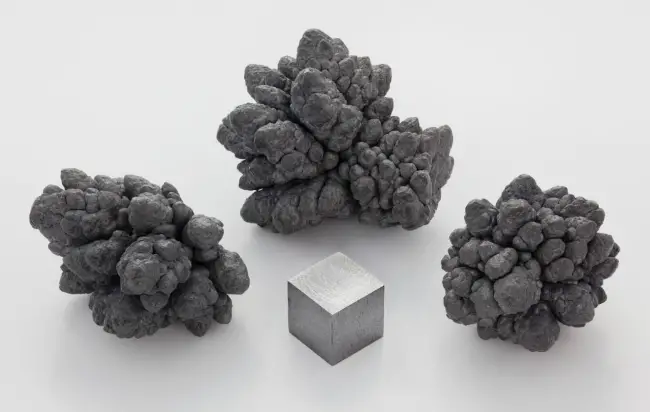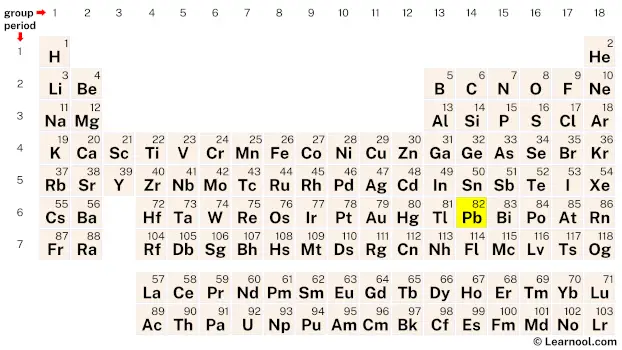
Lead (Pb) is a chemical element of the periodic table, located in the group 14 and the period 6, and is having the atomic number 82. It is a soft, malleable, lustrous, bluish-white post transition metal, whose name comes from the Anglo-Saxon word “lead”, which means metal. It is highly toxic and has a low melting point. It is a member of the carbon group.
On periodic table
| group | ⇨ | 1 | 2 | 3 | 4 | 5 | 6 | 7 | 8 | 9 | 10 | 11 | 12 | 13 | 14 | 15 | 16 | 17 | 18 |
| period | ⇩ | ||||||||||||||||||
| 1 | 1 H  Hydrogen |
2 He  Helium |
|||||||||||||||||
| 2 | 3 Li  Lithium |
4 Be  Beryllium |
5 B  Boron |
6 C  Carbon |
7 N  Nitrogen |
8 O  Oxygen |
9 F  Fluorine |
10 Ne  Neon |
|||||||||||
| 3 | 11 Na  Sodium |
12 Mg  Magnesium |
13 Al  Aluminium |
14 Si Silicon |
15 P  Phosphorus |
16 S  Sulfur |
17 Cl  Chlorine |
18 Ar  Argon |
|||||||||||
| 4 | 19 K  Potassium |
20 Ca  Calcium |
21 Sc  Scandium |
22 Ti  Titanium |
23 V  Vanadium |
24 Cr  Chromium |
25 Mn  Manganese |
26 Fe  Iron |
27 Co  Cobalt |
28 Ni  Nickel |
29 Cu  Copper |
30 Zn  Zinc |
31 Ga  Gallium |
32 Ge  Germanium |
33 As  Arsenic |
34 Se  Selenium |
35 Br  Bromine |
36 Kr  Krypton |
|
| 5 | 37 Rb  Rubidium |
38 Sr  Strontium |
39 Y  Yttrium |
40 Zr  Zirconium |
41 Nb  Niobium |
42 Mo  Molybdenum |
43 Tc  Technetium |
44 Ru  Ruthenium |
45 Rh  Rhodium |
46 Pd  Palladium |
47 Ag  Silver |
48 Cd  Cadmium |
49 In  Indium |
50 Sn  Tin |
51 Sb  Antimony |
52 Te  Tellurium |
53 I  Iodine |
54 Xe  Xenon |
|
| 6 | 55 Cs  Caesium |
56 Ba  Barium |
72 Hf  Hafnium |
73 Ta  Tantalum |
74 W  Tungsten |
75 Re  Rhenium |
76 Os  Osmium |
77 Ir  Iridium |
78 Pt  Platinum |
79 Au  Gold |
80 Hg  Mercury |
81 Tl  Thallium |
82 Pb Lead |
83 Bi  Bismuth |
84 Po  Polonium |
85 At  Astatine |
86 Rn  Radon |
||
| 7 | 87 Fr  Francium |
88 Ra  Radium |
104 Rf  Rutherfordium |
105 Db  Dubnium |
106 Sg  Seaborgium |
107 Bh  Bohrium |
108 Hs  Hassium |
109 Mt  Meitnerium |
110 Ds  Darmstadtium |
111 Rg  Roentgenium |
112 Cn  Copernicium |
113 Nh  Nihonium |
114 Fl  Flerovium |
115 Mc  Moscovium |
116 Lv  Livermorium |
117 Ts  Tennessine |
118 Og  Oganesson |
||
| 57 La  Lanthanum |
58 Ce  Cerium |
59 Pr  Praseodymium |
60 Nd  Neodymium |
61 Pm  Promethium |
62 Sm  Samarium |
63 Eu  Europium |
64 Gd  Gadolinium |
65 Tb  Terbium |
66 Dy  Dysprosium |
67 Ho  Holmium |
68 Er  Erbium |
69 Tm  Thulium |
70 Yb  Ytterbium |
71 Lu  Lutetium |
|||||
| 89 Ac  Actinium |
90 Th  Thorium |
91 Pa  Protactinium |
92 U  Uranium |
93 Np  Neptunium |
94 Pu  Plutonium |
95 Am  Americium |
96 Cm  Curium |
97 Bk  Berkelium |
98 Cf  Californium |
99 Es  Einsteinium |
100 Fm  Fermium |
101 Md  Mendelevium |
102 No  Nobelium |
103 Lr  Lawrencium |
|||||
| – p block |
Lead is a p-block element, situated in the fourteenth column (carbon group) of the periodic table, between thallium (Tl) and bismuth (Bi). It has the atomic number 82 and is denoted by the symbol Pb.
Element information
 |
|
 |
|
| Origin of name | Anglo-Saxon word “lead” (which means metal) |
| Symbol | Pb |
| Atomic number (Z) | 82 |
| Atomic mass | 207.2 u |
| Block | p-block |
| Group | 14 (carbon group) |
| Period | 6 |
| Classification | Post-transition metal |
| Atomic radius | 175 pm |
| Covalent radius | 146±5 pm |
| Van der Waals radius | 202 pm |
| Melting point | 327.46 ℃, 621.43 ℉, 600.61 K |
| Boiling point | 1749 ℃, 3180 ℉, 2022 K |
| Electron configuration | [Xe] 4f14 5d10 6s2 6p2 |
| Learn how to write: Lead electron configuration | |
| Electrons per shell | 2, 8, 18, 32, 18, 4 |
| Learn how to draw: Lead Bohr model | |
| Crystal structure | Face-centered cubic (fcc) (α=495.08 pm) |
| Phase at r.t | Solid |
| Density near r.t | 11.34 g/cm3 |
| Main isotopes | Lead-204, Lead-206, Lead-207, Lead-208 |
| Natural occurrence | Primordial |
| Oxidation state | +2, +4 |
| Electronegativity (Pauling scale) | 2.33 |
| Protons Neutrons Electrons |
82 125 82 |
| Learn how to find: Lead protons neutrons electrons | |
| Valence electrons | 4 |
| Learn how to find: Lead valence electrons | |
| CAS number | 7439-92-1 |
| Discovered in | Middle East around 7000 BCE |
History
The history of lead dates back to 7000-6500 BCE, where metallic lead beads were found in Asia Minor, representing the first example of metal smelting. At that time, lead had few applications due to its softness and dull appearance. However, the major reason for the spread of lead production was its association with silver, which could be obtained by burning galena, a common lead mineral.
The ancient Egyptians were the first to use lead minerals in cosmetics, and this application spread to Ancient Greece and beyond. The Egyptians may have also used lead for sinkers in fishing nets, glazes, glasses, enamels, and ornaments. Various civilizations of the Fertile Crescent used lead as a writing material, as coins, and as a construction material. Lead was used in the Ancient Chinese royal court as a stimulant, currency, and as a contraceptive. The Indus Valley civilization and the Mesoamericans used it for making amulets, while eastern and southern African peoples used lead in wire drawing.
In the Middle Ages, lead was used for roofing, piping, and pewter. It was also used in stained glass windows, and for decorative purposes. Lead played an important role in the development of printing, as it was used to make movable type. However, the toxicity of lead was not fully understood at the time, and many craftsmen suffered from lead poisoning. In the 19th and 20th centuries, lead became an important component of batteries, and its use in gasoline became widespread. However, the health hazards associated with lead exposure led to a decline in its use, and today, lead is primarily used in the production of batteries, ammunition, and radiation shielding.
Lead poisoning is a serious health concern and can cause irreversible damage to the nervous system and other organs. Due to this, the use of lead has been heavily regulated in recent years, and efforts have been made to reduce its environmental impact. Despite its toxicity, lead has played an important role in human history, from the earliest examples of metal smelting to the development of printing and the modern use of batteries.
Occurrence and production
Lead is a naturally occurring element found in the earth’s crust. It is a relatively abundant element and is widely distributed throughout the world. The main sources of lead include galena (lead sulfide), cerussite (lead carbonate), anglesite (lead sulfate), and minim (lead oxide). These minerals are often found in conjunction with other minerals such as zinc, silver, and copper. Lead is usually produced from its ores by a combination of roasting, reduction, and refining processes.
Roasting involves heating the ore in the presence of air to remove sulfur and other impurities. The resulting product is a lead oxide that is then reduced using carbon or another reducing agent. The reduced lead is then refined to remove any remaining impurities and to produce pure lead. This process can be repeated multiple times to increase the purity of the final product.
In addition to the above methods, lead can also be produced from recycled materials such as lead-acid batteries and other scrap sources. Recycling is an important source of lead production, as it helps to reduce the environmental impact of mining and refining processes.
Properties
Lead is a soft, malleable, and heavy metal that is bluish-white when freshly cut but tarnishes to dull gray upon exposure to air.
It has a low melting point and a relatively low boiling point compared to other metals.
Lead is a poor conductor of electricity and is a diamagnetic material, which means it has no magnetic properties.
It is highly resistant to corrosion, making it useful in the production of pipes, tanks, and other equipment that come into contact with chemicals and corrosive substances.
Lead is also highly toxic, and exposure to it can cause a range of health problems, including damage to the nervous system, kidneys, and reproductive system.
Applications
Batteries
Lead is an essential component in lead-acid batteries which are commonly used in vehicles, uninterruptible power supplies, and other applications where reliable power storage is needed.
Radiation shielding
Due to its high density and atomic number, lead is an excellent material for radiation shielding. It is used to line X-ray rooms, nuclear power plants, and other facilities where radiation exposure is a concern.
Construction
Lead is a popular material for roofing and flashing due to its malleability, durability, and resistance to corrosion. It is also used in the construction of soundproof rooms, where its density helps to block out sound.
Ammunition
Lead has been used in the manufacture of bullets and shot for centuries due to its high density and ability to deform upon impact.
Pigments
Lead-based pigments have been used in paints for centuries due to their brightness, durability, and resistance to weathering. However, their use has declined in recent decades due to concerns over lead poisoning.
Other applications
Lead is also used in the manufacture of bearings, solder, and cable sheathing. Additionally, lead compounds are used in the production of some ceramics, glass, and plastics.
Interesting facts
The chemical symbol for lead, Pb, comes from the Latin word plumbum, which means “liquid silver”.
Lead has been used by humans for thousands of years, dating back to ancient civilizations such as the Romans and Egyptians.
Lead was once commonly used in gasoline, paint, and pipes, but its toxicity led to its phasing out in these applications.
Lead has a high density, making it useful in weights, such as for fishing sinkers and scuba diving belts.
Lead is a poor conductor of electricity and has a low melting point, making it useful as a radiation shield and for soldering metals.
Lead is the heaviest stable element and has no radioactive isotopes.
Lead is toxic to humans and animals, causing damage to the nervous system, kidneys, and other organs. Even low levels of exposure can be harmful, especially for children.
Related
More elements
External links
- https://www.rsc.org/periodic-table/element/82/lead
- https://en.wikipedia.org/wiki/Lead
- https://www.britannica.com/science/lead-chemical-element
- https://pubchem.ncbi.nlm.nih.gov/element/Lead
- https://www.chemicool.com/elements/lead.html
- https://education.jlab.org/itselemental/ele082.html
- https://chemistrytalk.org/lead-element/
- https://www.ducksters.com/science/chemistry/lead.php
- https://www.thoughtco.com/lead-element-facts-608167
Deep
Learnool.com was founded by Deep Rana, who is a mechanical engineer by profession and a blogger by passion. He has a good conceptual knowledge on different educational topics and he provides the same on this website. He loves to learn something new everyday and believes that the best utilization of free time is developing a new skill.
